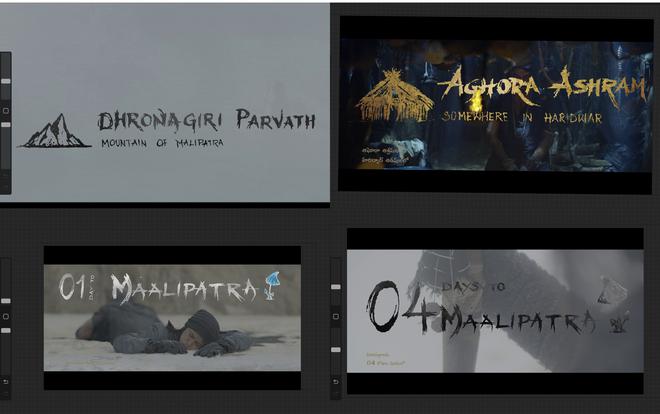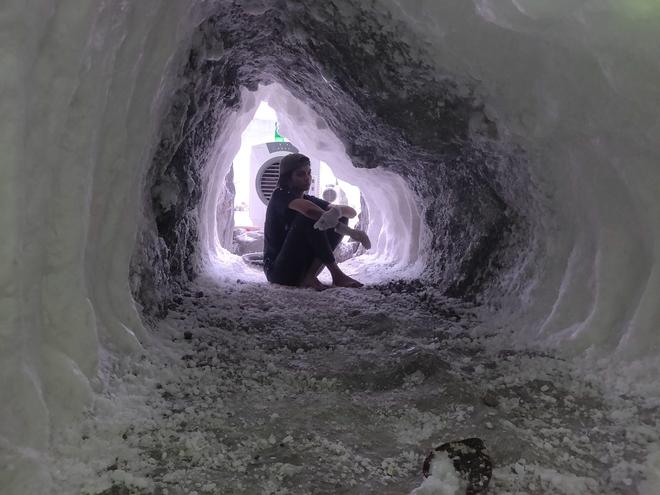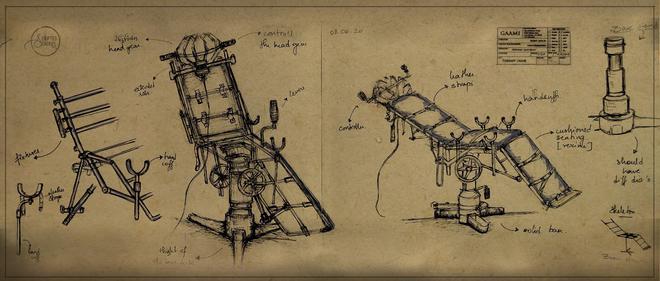“I was confident that I could count on my painting skills,” says Pravalya Duddupudi, while discussing a rough patch in her professional sphere when she looked for freelance work as an artist to supplement her income. The Hyderabad-based multi-disciplinary artist, skilled in calligraphy, painting, sculpture and interior design, made the audience and the Telugu film industry take note of her production design for the film Gaami. Her work did not end with designing nearly a dozen sets. The film’s title logo, symbolic of the yin and yang of the circle of life, and the calligraphy of text inserts such as ‘14 days to malapatra (magic mushrooms)’, accompanied by imagery, were her handiwork.
In a freewheeling conversation at a cafe in Hyderabad, Pravalya talks about handling multiple responsibilities fuelled by the creative urge. “For a year, I barely slept a few hours. I had a day job (at an interior design firm) and worked on the film late evenings and nights. The dopamine rush kept me going. I don’t know if I can pull off something like that again, unless a script interests me.”
The 28-year-old is among the handful of female production designers in Telugu cinema. Gaami was the first film she signed, and since it had been in the making for a few years, the films she took on later, Ashoka Vanamlo Arjuna Kalyanam and Ustaad, were released earlier.
Artistic leanings
Pravalya says her artistic inclination came naturally since her grandfather used to paint and her father is adept at calligraphy. Her father being in the Indian Army, she spent her childhood in different cities before they moved to Visakhapatnam. Though she took the entrance examination for MBBS, she knew she was not cut out for it.
Around that time, she learnt about the National Institute of Fashion Technology (NIFT). “Initially, I did not discuss it with my parents. But I had to tell them when I had to travel to Hyderabad for the final tests and counselling. They were concerned if the fashion industry would be appropriate for me.” It took some prodding and convincing, with the help of a close relative, and they relented. They were also apprehensive when she began working on film sets. “Today, they are proud of what I have done for Gaami.”
Pravalya recalls her first experience of designing a film set in 2019. She was just out of NIFT Hyderabad, where she was in the lifestyle and accessories design department. “My friend (actor) Aditi Myakal said the film unit she was working for was looking for someone to design a set. I met the producer, who told me they needed a set that looked like the interiors of a club but had a limited budget. I designed it in three days.” It opened new doors. Karthik Sabareesh, the producer of Gaami, met her on the sets and later asked if she would work on his film.
The hand-drawn approach
“I knew nothing about the film industry and did not know whom to trust,” says Pravalya. She visited Karthik’s office and noticed that it was teeming with men. She was nervous until she met director Vidyadhar Kagita and his co-writer Pratyush. “From the images they had, I understood they were onto something different. I noticed a printed map that shows Vishwak Sen the direction to the magical mushrooms in the Himalayas. A printed map was not in synergy with the world they were trying to create. I offered to give them a hand painted, dyed and aged map.” Then, she worked on a scroll and a book they handed her. Impressed with her artistic skills, the team asked if she could help design and construct sets for the film.

The journey seemed creatively challenging but there was a stumbling block. Pravalya needed a steady income to repay her student loan and for her paying guest accommodation in Hyderabad. “Since Gaami began as a crowdfunded indie film, they could not pay me monthly. So, I decided to keep my day job and work on the film in the evenings and nights.”
The icebreaker between her and the core team of Gaami was when they designed the monastery set together. “It was just me, Pratyush, Vidyadhar, Karthik and two assistant directors. I also read the script and was blown away.”
Notes from ‘Game of Thrones’
As the film progressed, Pravalya hired the manpower required for the tasks. One of the first challenges was to design a frozen waterfall to film the visual effects portions of the Himalayas. She had to design a 30x15-foot waterfall. She researched the materials required and also pored over interviews of Deborah Riley, production designer of Game of Thrones, for further information. She hit a dead end. She then contacted Deborah through LinkedIn. “To my surprise, she responded in a day. She said my research was in the right direction and told me about a Canada-based firm that works on ice sets for Hollywood films. That she responded to a beginner like me boosted my confidence.” The Gaami team did not have the resources to rope in the firms suggested by Deborah, but Pravalya executed the task with the help of NIFT students.

The lockdown of 2020 changed the course of things. “I decided to leave my interior design job since my pay was halved. Thanks to Instagram, I landed a few freelance assignments. I designed murals and sculptures on order and helped people revamp their homes. I also conducted a few art workshops. The income was not steady, but it helped.”
Meanwhile, for Gaami, she learnt to reuse and repurpose certain materials to cut down expenditure. Constructing the sets for the illegal medical facility with its claustrophobic cell, lobotomy lab and narrow corridors was crucial. Trial and error helped get the weathered look. She roped in a mason from the construction industry, oversaw the mixing of cement and sand to get the grainy texture for the walls of the cell of the character CT-333 (played by Mohammad Samad). She then mixed the paints herself. “It had to look grunge. So, for each colour, for example, green, I would mix five different shades of green, dilute it, and splash mugs of paint on the walls. The way it trickles down would create uneven textures, as though the wall has witnessed water seepage.”
Immovable walls

The claustrophobic interiors are thanks to Pravalya eschewing the use of movable walls, even if it meant limited space for the film crew. “If the edges don’t blend, it is a giveaway that it is a set. It had to look real. I would check the monitor and exit the sets and the shooting would progress with just the actors required for a scene, the director, the director of photography (Vishwanath Reddy) and a focus puller.” The corridor, she adds, was designed to be a little over six feet high, barely accommodating the character of Mojo, to give the illusion of him being imposing.
As appreciation continues to come her way since the film’s release, Pravalya is hopeful she gets to design sets with an artistic touch. “Sometimes people are sceptical about whether I can handle male-centric crews with my soft-spoken nature. I don’t think it is necessary to raise my voice to make my point.”
There are other plans as well: “Some day, I want to create a public installation that would outlive me and be considered a monument.”







